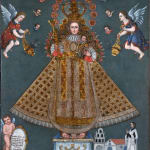OUR LADY OF GUADALUPE OF EXTREMADURA
Provenance
Private collection
The great veneration inspired by Extremadura’s Our Lady ofGuadalupe meant it became one of the most widely-depicted images over the centuries in a number of artistic formats, both in Spain and on the other side of the Atlantic.
The origin of the iconography goes back to a miraculous event that occurred to a cowherd from Cáceres (Extremadura, Spain), Gil Cordero, in the late 13th century in the nearby Guadalupe river area.12 After it had been lost for several days, Gil came across the dead body of one of his cows and, just as he was about to skin it for its hide, it came back to life. The Virgin then appeared to him, speaking the following words: “… you will go back to your lands, and you will tell the clerics and other people to come to this place where I appeared to you, and to dig here, and they will find an image of me.” A group of people subsequently travelled to said location, and there they found a wooden carving of the Virgin.
Shortly after, King Alphonse XI, having learnt of the apparition, invoked Our Lady of Guadalupe at the Battle of Río Salado (1340), after which his troops were victorious. In gratitude, he granted the recently-created Monastery of Guadalupe royal privileges and concessions, which turned it into a site of great veneration and pilgrimage, guarded by the monks of the Order of St. Jerome. Over the centuries, devotion to the Virgin spread widely, even reaching the Americas, with the Hieronymite friar Diego de Ocaña responsible for its dissemination. Between 1599 and 1608, he travelled the majority of the Spanish viceregal territories, accompanied, the chronicles say, by 300 copies of the recently-published Historia de Nuestra Señora de Guadalupe (History of Our Lady of Guadalupe), friar Gabriel de Talavera's work, with the goal of leaving a faithful account of Guadalupe’s devotion and history wherever he went, also increasing and maintaining veneration for her over time, which would translate into financial donations for her Shrine in Extremadura. To this we should also add the artistic skills of Ocaña himself, who went so far as to leave visual depictions of the image of Our Lady in each place he passed through. The Spanish engraver Pedro Ángel (c. 1567–1618) was also key to Our Lady’s iconography taking root in the various viceregal territories, having designed a print to be included on the inside cover of Father Talavera’s aforementioned publication. As such, along with the descriptions in the work itself, native artists had a clear and direct guide to depicting the Virgin correctly.
At some point in their careers, many major viceregal painters undertook to portray this subject. One of the first was the Peruvian artist Gregorio Gamarra (c. 1570–1642), followed some decades later by the Colombian Gregorio Vásquez de Arce y Ceballos (1638–1711).
The work we have before us here relates to a later depiction. We can date it exactly thanks to the explanatory cartouche held by a cherub towards the bottom of the composition, reading “Verdadero retrato de Nuestra Señora. de Guadalupe de Chairapata, a devoción de Su Párroco el D. D. Manuel de Lossada, y Amezaga Año de 1813.” (True portrait of Our lady of Guadalupe of Chairapata, for the devotion of its Parish Priest the D.D. Manuel de Lossada, y Amezaga Year 1813).
We can therefore conclude the work was executed at the behest of a parish priest whose surnames take us to the north of Spain, presenting him, along with his church, as the figure behind the commission.
But that takes none of the limelight away from Our Lady of Guadalupe herself. The Marian image appears standing atop a simple pedestal. She is wearing her characteristic triangular cloak decorated with beautiful embroidery featuring floral motifs, gilt brocade, cuffs and collar made of fine white lace, pearl necklace and earrings. The Child, meanwhile, is also sumptuously dressed in brocade in the Cuzco style, with lace cuffs and collar and gold shoes.
Both are pictured face on, looking serious and solemn. It is worth noting Mary’s pale skin, given the original image from Extremadura was actually part of the group of “Black Madonnas”, so called due to their dark skin. Our Virgin is carrying the symbol of Guadalupe in her right hand, a scepter made of gold and precious gemstones, and on her head she has a crown from which a colorful floral veil is seen to emerge. Her virginal status is reinforced by the 10 stars over her head and the crescent moon under her feet, linking her to the Immaculate Conception. The Child, meanwhile, is holding the orb of the world in his left hand, while issuing a benediction with his right.
One of the basic elements of this iconography, missing on this occasion, is the hanging drape, replaced here by a simple neutral celestial background from which little cherubim are seen to emerge, and two beautiful thurifer angels in elegant dress, carrying finely-made censers, matching the overall feeling of luxury and ostentation.



